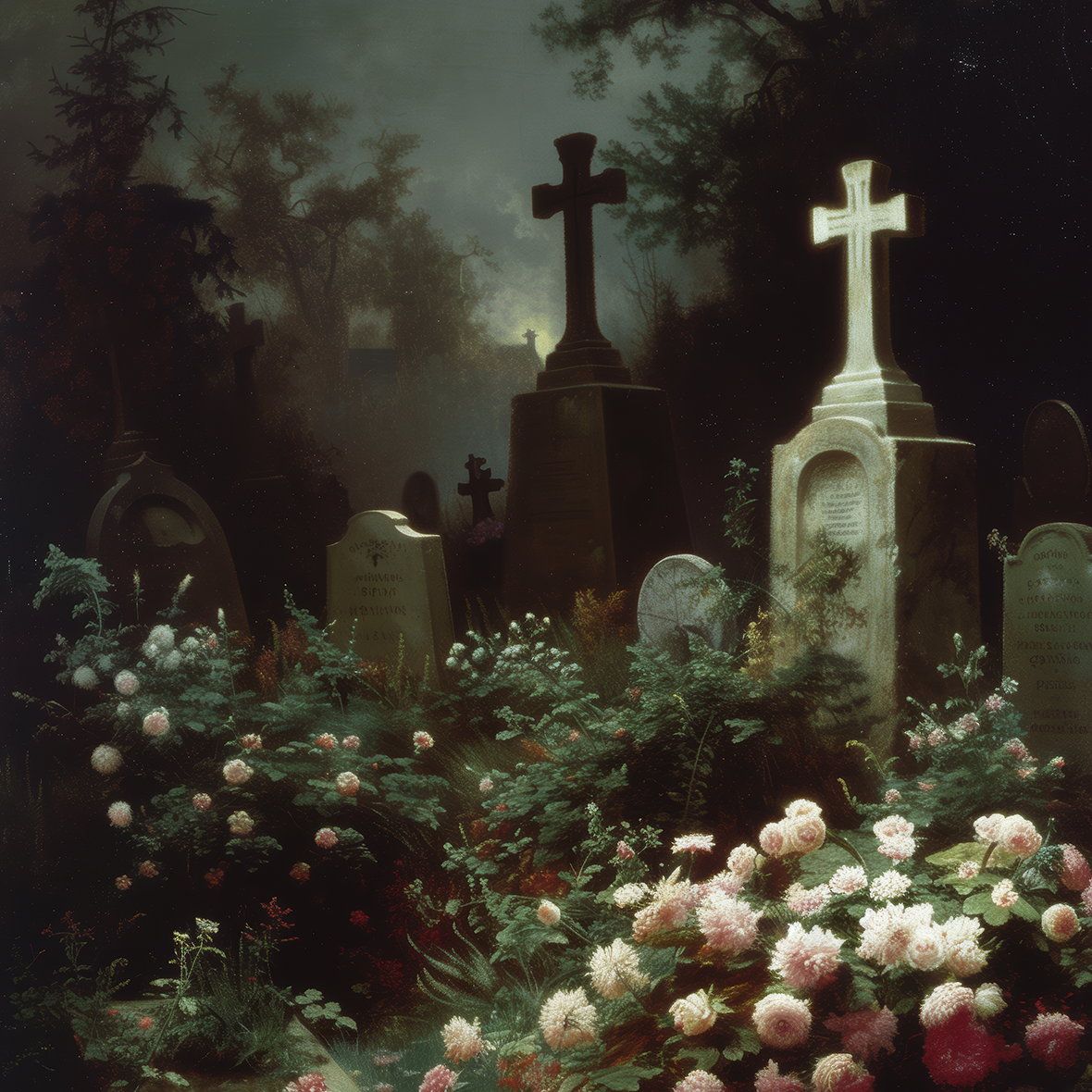The Old Gray
Some places are sacred not because they’re silent but because they remember. In the heart of Knoxville, where ivy tangles through iron gates and names fade beneath the moss-covered stone, Old Gray Cemetery breathes with memory. It is not haunted in the way of fear but in the way of longing—full of soft footsteps, whispered names, and love too deep to end with death. This is where grief becomes a garden, and remembrance is its bloom.
Scent Profile
Top: Pink Peppercorn, Grapefruit, Plum
Heart: Black Rose, Cumin
Base: Vanilla, Patchouli, Labdanum
Scent Profile
Top: Pink Peppercorn, Grapefruit, Plum
Heart: Black Rose, Cumin
Base: Vanilla, Patchouli, Labdanum

The Old Gray
Cemetary
A hush among headstones, a rose left for the dead.
In the heart of Knoxville, where the living brush shoulders with memory, there is a place where time sinks gently into the soil. Old Gray Cemetery is not just a resting ground for the departed—it is a landscape of echoes, a garden of grief and grace, where stone angels watch over the silence and ivy-wrapped monuments speak without words.
Wrought-iron fences line its perimeter like lace cast in shadow. Moss-draped trees bend low as if in reverence. Marble urns and Gothic obelisks catch the soft Tennessee light, casting long shadows across winding paths. Birds do not sing here as they do elsewhere; they murmur. And the wind, when it stirs, feels less like a breeze and more like a sigh.
Locals call it haunted, not in the way of horror movies, but with something gentler—a presence, a chill, a pause that lingers a beat too long. Some say they've seen a woman in gray placing roses on a grave no one remembers. Others speak of a boy chasing a ball between the stones, vanishing before it can be caught. But no one feels afraid. Old Gray is not a place of unrest. It is a place of holding on.
Established in 1850, it was named not for sorrow but for a poet—Thomas Gray, author of Elegy Written in a Country Churchyard. Fitting, then, that the cemetery reads like a poem itself. Each grave a stanza—each statue a metaphor for love, for loss, for what we try so hard to remember.
There are graves here so old the names have worn away; inscriptions softened to a whisper. Others are fresh, flowers still bright against the granite. There is no hierarchy in Old Gray. Union generals lie beside farmers. Children beside centenarians. Artists beside factory men. And in every direction, stories rest beneath the soil, waiting for a listener.
Legend holds that during the yellow fever epidemic of the 1870s, a nurse named Margaret McCall tended to the sick and dying with nothing but a lantern and her stubborn will. When she herself succumbed, townsfolk lit lanterns along the cemetery path to guide her spirit home. Some say you can still see that flickering light at dusk, especially in October, bobbing just ahead like a will-o'-the-wisp, always disappearing before it's reached.
Another tale tells of a young bride, buried in her wedding dress after a tragic accident the night before her vows. On misty mornings, the dew clings to one grave like lace. Visitors sometimes find white rose petals scattered near the headstone, even in winter, when no roses bloom. Once, a photographer attempted to capture the phenomenon, but the images returned blurred—each frame filled with soft light and a smear of what looked like fabric mid-spin.
There's a stone bench under the oldest cedar tree in the cemetery—a gnarled sentinel whose roots weave through generations. It's said that if you sit there long enough, with an open heart and quiet mind, you'll hear someone whisper your name. Not in fear, but in recognition. As if you've been expected.
One woman who frequents the grounds swears she once followed the sound of humming to a grave with no name. She left a daffodil and walked away. The next time she visited, her own name was etched faintly into the bark of the nearest tree. She never returned but sent others in her place, asking only that they bring yellow flowers.
Children who grow up nearby often speak of dreams filled with carved angels and soft voices. They describe entire conversations with those long gone and sometimes wake with dirt beneath their nails and dried petals in their hair. Parents don't ask too many questions. Not in Knoxville. Not if the child seems peaceful.
An elderly man visits each week and leaves a penny on the same grave. No one knows why, but each time he does, the birds gather in the cedar overhead and remain silent until he departs. He never speaks while there. Just nods, as if listening to someone invisible and kind.
Local historians have tried to document the stories but often find their recordings distorted, their pens running dry mid-sentence. One archivist claimed that she lost an entire hour while transcribing headstone inscriptions. She left the grounds shaken, clutching a scrap of paper with only two words scrawled on it: "Still remembered."
A visiting folklorist once tried to map the cemetery's hauntings. She returned each season, noting changes in temperature, birdsong, and light. Her notes became stranger each visit—less data, more poetry. Her final entry read: There is no fear here—only longing. The graves speak in the language of love withheld too long.
Some believe Old Gray is watched over not by ghosts but by memory itself—sentient, sacred, and selective. It keeps what it chooses. It reveals what it wills. It remembers the forgotten and forgets only the unforgiven.
Weddings have taken place there, as have funerals decades apart for members of the same bloodline. Proposals, reconciliations, and even confessions whispered into the roots of trees. The cemetery accepts them all without judgment as if it understands what it means to love and to lose, to remember and to try.
There's a tree at the far edge where ribbons appear tied to the branches every spring. No one knows who places them. Blue, white, red—fluttering like prayers. Sometimes, they vanish by summer. Sometimes, they stay until they rot away. Some say the ribbons are promises. Others say they're apologies.
A man once claimed he met his wife there—decades after she died. He visited her grave on their anniversary, and when he looked up, there she was, sitting on the bench beneath the cedar, wearing the same yellow dress she was buried in. They didn't speak. But when he blinked, she was gone, and a single yellow rose lay across the bench. He told no one for years. Then, near the end of his life, he returned one last time and lay down beside her grave. When the caretaker found him, he was smiling.
There are those who believe the cemetery is a threshold—that the space between life and death is thinner here, not a wall but a veil. The kind of veil that lifts when the air cools and the light turns to gold. People who have wept here often say they leave feeling lighter as if something unspoken had been acknowledged, as if grief itself had knelt beside them for a moment and offered its hand.
In autumn, the grounds smell of damp leaves and far-off wood smoke. In spring, of violets and thawed earth. But always, beneath it all, there is something older. The scent of stone and memory. A hush in the blood. A kind of stillness that isn't empty but full.
Old Gray is a place where grief takes root not as something sharp but as something quiet. A hum. A hymn. It is not a place of endings but of echoes, not of terror but of tenderness. To walk its paths is to take part in a centuries-long conversation—with loss, with love, with what remains after everything else has gone.
Step softly.
Breathe deeply.
And listen.
The dead are never unkind here. Only waiting to be remembered.
In the heart of Knoxville, where the living brush shoulders with memory, there is a place where time sinks gently into the soil. Old Gray Cemetery is not just a resting ground for the departed—it is a landscape of echoes, a garden of grief and grace, where stone angels watch over the silence and ivy-wrapped monuments speak without words.
Wrought-iron fences line its perimeter like lace cast in shadow. Moss-draped trees bend low as if in reverence. Marble urns and Gothic obelisks catch the soft Tennessee light, casting long shadows across winding paths. Birds do not sing here as they do elsewhere; they murmur. And the wind, when it stirs, feels less like a breeze and more like a sigh.
Locals call it haunted, not in the way of horror movies, but with something gentler—a presence, a chill, a pause that lingers a beat too long. Some say they've seen a woman in gray placing roses on a grave no one remembers. Others speak of a boy chasing a ball between the stones, vanishing before it can be caught. But no one feels afraid. Old Gray is not a place of unrest. It is a place of holding on.
Established in 1850, it was named not for sorrow but for a poet—Thomas Gray, author of Elegy Written in a Country Churchyard. Fitting, then, that the cemetery reads like a poem itself. Each grave a stanza—each statue a metaphor for love, for loss, for what we try so hard to remember.
There are graves here so old the names have worn away; inscriptions softened to a whisper. Others are fresh, flowers still bright against the granite. There is no hierarchy in Old Gray. Union generals lie beside farmers. Children beside centenarians. Artists beside factory men. And in every direction, stories rest beneath the soil, waiting for a listener.
Legend holds that during the yellow fever epidemic of the 1870s, a nurse named Margaret McCall tended to the sick and dying with nothing but a lantern and her stubborn will. When she herself succumbed, townsfolk lit lanterns along the cemetery path to guide her spirit home. Some say you can still see that flickering light at dusk, especially in October, bobbing just ahead like a will-o'-the-wisp, always disappearing before it's reached.
Another tale tells of a young bride, buried in her wedding dress after a tragic accident the night before her vows. On misty mornings, the dew clings to one grave like lace. Visitors sometimes find white rose petals scattered near the headstone, even in winter, when no roses bloom. Once, a photographer attempted to capture the phenomenon, but the images returned blurred—each frame filled with soft light and a smear of what looked like fabric mid-spin.
There's a stone bench under the oldest cedar tree in the cemetery—a gnarled sentinel whose roots weave through generations. It's said that if you sit there long enough, with an open heart and quiet mind, you'll hear someone whisper your name. Not in fear, but in recognition. As if you've been expected.
One woman who frequents the grounds swears she once followed the sound of humming to a grave with no name. She left a daffodil and walked away. The next time she visited, her own name was etched faintly into the bark of the nearest tree. She never returned but sent others in her place, asking only that they bring yellow flowers.
Children who grow up nearby often speak of dreams filled with carved angels and soft voices. They describe entire conversations with those long gone and sometimes wake with dirt beneath their nails and dried petals in their hair. Parents don't ask too many questions. Not in Knoxville. Not if the child seems peaceful.
An elderly man visits each week and leaves a penny on the same grave. No one knows why, but each time he does, the birds gather in the cedar overhead and remain silent until he departs. He never speaks while there. Just nods, as if listening to someone invisible and kind.
Local historians have tried to document the stories but often find their recordings distorted, their pens running dry mid-sentence. One archivist claimed that she lost an entire hour while transcribing headstone inscriptions. She left the grounds shaken, clutching a scrap of paper with only two words scrawled on it: "Still remembered."
A visiting folklorist once tried to map the cemetery's hauntings. She returned each season, noting changes in temperature, birdsong, and light. Her notes became stranger each visit—less data, more poetry. Her final entry read: There is no fear here—only longing. The graves speak in the language of love withheld too long.
Some believe Old Gray is watched over not by ghosts but by memory itself—sentient, sacred, and selective. It keeps what it chooses. It reveals what it wills. It remembers the forgotten and forgets only the unforgiven.
Weddings have taken place there, as have funerals decades apart for members of the same bloodline. Proposals, reconciliations, and even confessions whispered into the roots of trees. The cemetery accepts them all without judgment as if it understands what it means to love and to lose, to remember and to try.
There's a tree at the far edge where ribbons appear tied to the branches every spring. No one knows who places them. Blue, white, red—fluttering like prayers. Sometimes, they vanish by summer. Sometimes, they stay until they rot away. Some say the ribbons are promises. Others say they're apologies.
A man once claimed he met his wife there—decades after she died. He visited her grave on their anniversary, and when he looked up, there she was, sitting on the bench beneath the cedar, wearing the same yellow dress she was buried in. They didn't speak. But when he blinked, she was gone, and a single yellow rose lay across the bench. He told no one for years. Then, near the end of his life, he returned one last time and lay down beside her grave. When the caretaker found him, he was smiling.
There are those who believe the cemetery is a threshold—that the space between life and death is thinner here, not a wall but a veil. The kind of veil that lifts when the air cools and the light turns to gold. People who have wept here often say they leave feeling lighter as if something unspoken had been acknowledged, as if grief itself had knelt beside them for a moment and offered its hand.
In autumn, the grounds smell of damp leaves and far-off wood smoke. In spring, of violets and thawed earth. But always, beneath it all, there is something older. The scent of stone and memory. A hush in the blood. A kind of stillness that isn't empty but full.
Old Gray is a place where grief takes root not as something sharp but as something quiet. A hum. A hymn. It is not a place of endings but of echoes, not of terror but of tenderness. To walk its paths is to take part in a centuries-long conversation—with loss, with love, with what remains after everything else has gone.
Step softly.
Breathe deeply.
And listen.
The dead are never unkind here. Only waiting to be remembered.


-Photoroom.jpg)

